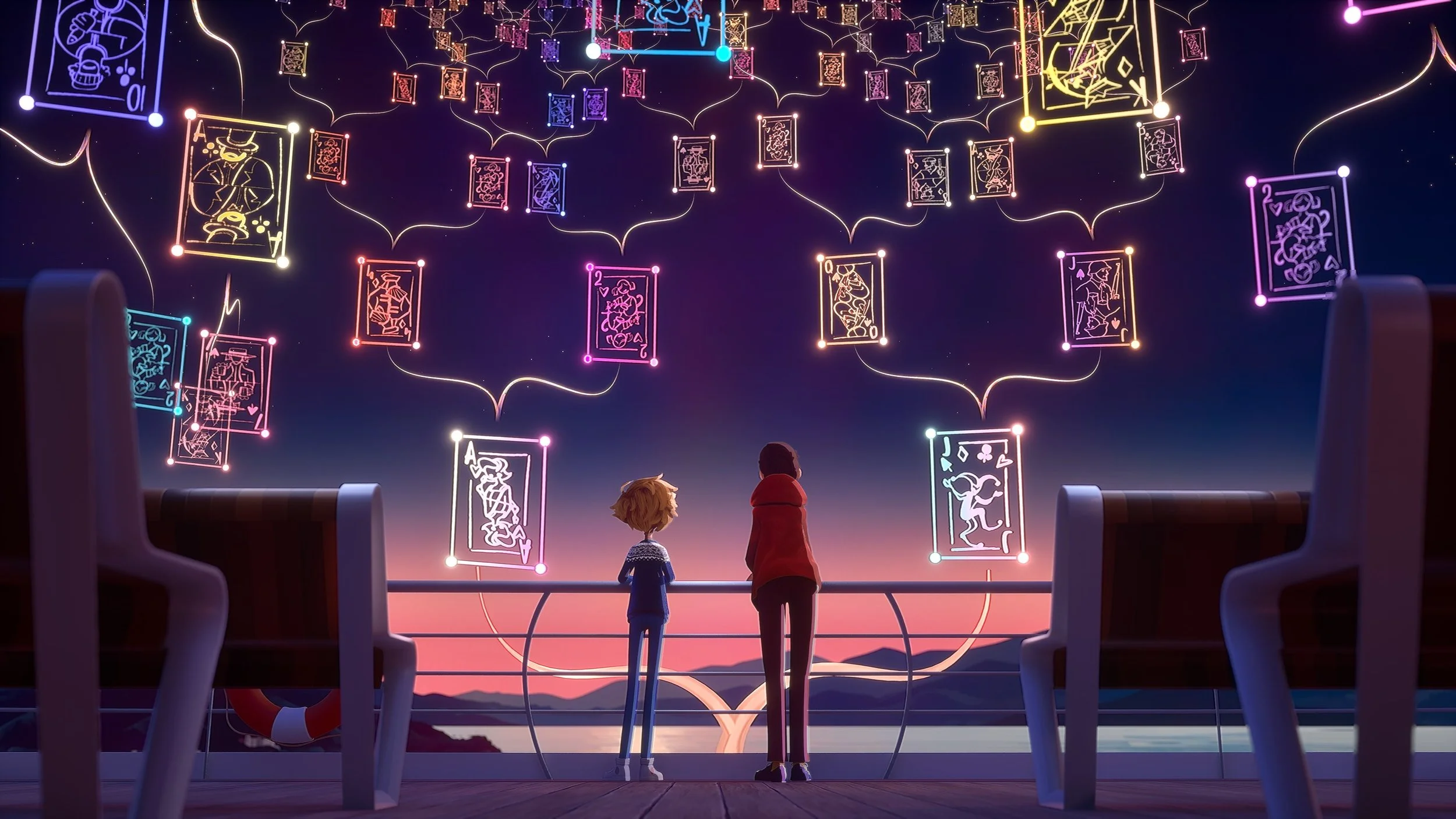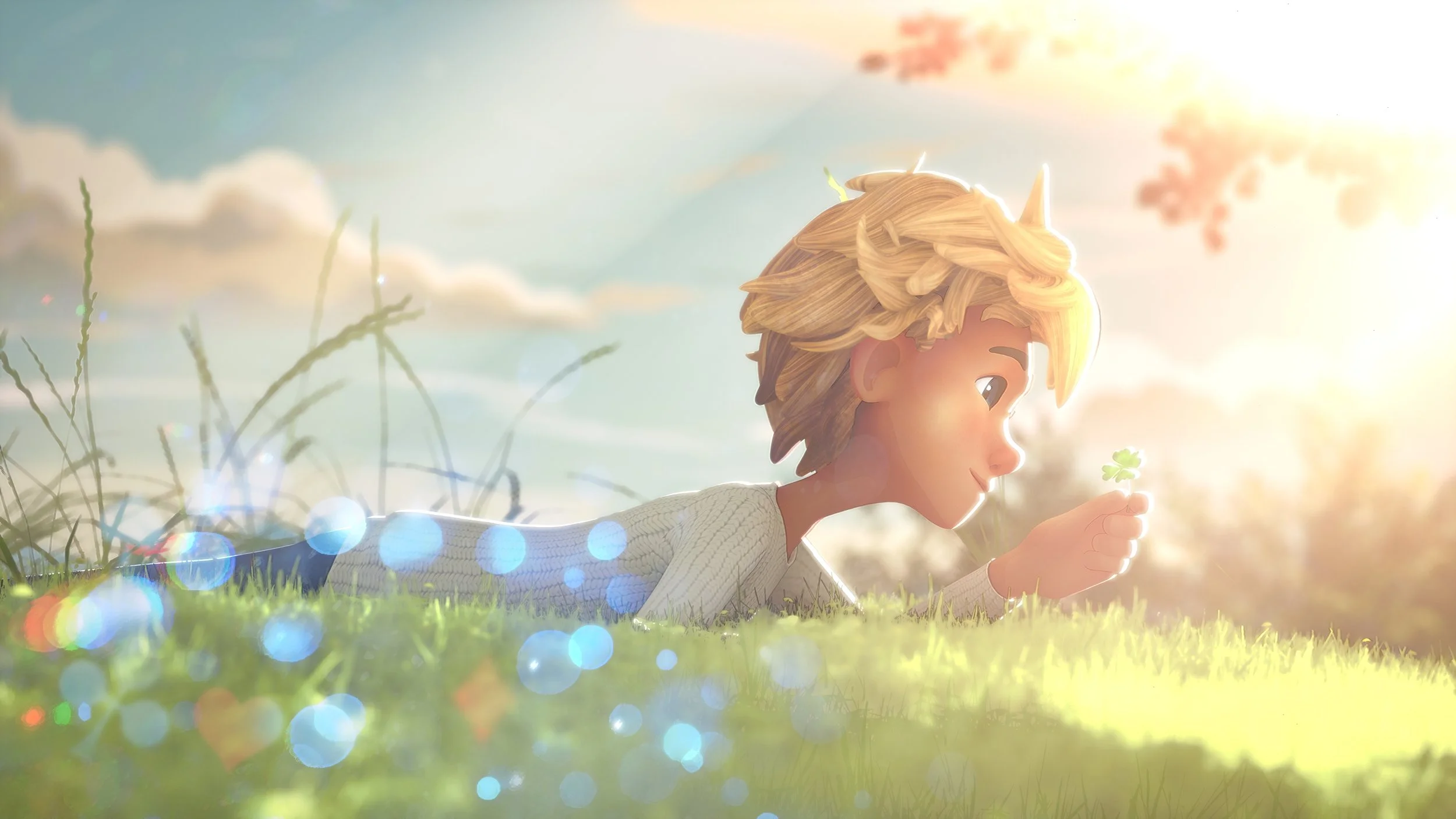
The Winning Lottery Ticket
It’s 2002 and ten year old Tash is working on her personal interest project in school. The topic she chose is philosophy. In it, she describes the wonder of all of us alive today being here - the sheer odds of every single ancestor before us having survived to child bearing age being one in a million, making us all winning lottery tickets; an idea that fascinated her since reading The Solitaire Mystery with her Dad, the fantastical and philosophical novel by Jostein Gaarder.
Fast forward to 2023 and Tash is now producing and directing The Winning Lottery Ticket, a short section of the feature, with the small but mighty team at Engine House.
Creative Catalyst
In the summer of 2023, we applied for Innovate UK’s Creative Catalyst Grant, with a view to further developing our realtime pipeline further by building a suite of custom tools to speed up procedural sections of the animation process, allowing for more time spent on creative and the ability to create high quality content on a lower budget.
We were delighted to be awarded this grant, and set off on our mission to innovate our new approach and create a five minute section of our feature film in development as a standalone short film, to both test and demo our ideas.
Notion and Unreal
Rather than relying on conventional project management tools like ShotGrid, which can often be overloaded with features that don’t necessarily align with our specific workflow, we are taking a more innovative approach by developing a highly tailored system on Notion. This allows us to customise our project management to fit the unique needs of each individual project, ensuring that every element is aligned with our creative vision and operational efficiency.
One of the standout features of our Notion setup is its adaptability. As projects evolve, we can easily tweak and modify the system without the lengthy process of adjusting to rigid software. This flexibility empowers our team to stay focused on creativity rather than getting bogged down by administrative tasks.
To further streamline our workflow, we’ve integrated some Python coding to establish a direct connection between Notion and Unreal Engine. This integration is a game changer, as it eliminates cumbersome procedural steps that would otherwise consume precious time and resources. By automating data transfer and task management between the two platforms, our artists can spend significantly more time on the creative aspects of their work.
For instance, shot lists and asset details can now be seamlessly updated in Notion and instantly reflected in Unreal Engine, allowing our team to access real-time information without manual data entry. This not only boosts productivity but also enhances collaboration, as everyone is on the same page, working with the most up-to-date information.
Process
Whilst building many new tools and workflows, much of our creative process followed a fairly typical animation pipeline. The first step was selecting and tweaking the key section of the script to focus on for The Winning Lottery Ticket. Once we had the scene locked, we jumped straight into creating a rough previsualization (previz) in Unreal Engine. This allowed us to quickly experiment with shot types, angles, and the pacing of each scene, helping us define the overall look and feel of the short film. Unreal’s flexibility in real-time rendering made this phase incredibly dynamic, letting us make fast, informed decisions on cinematography and shot lengths.
Simultaneously, we were developing the two main characters—starting with early concept art to establish their personalities and appearances. From there, we took them through the full design process, including modeling, texturing, and rigging, ensuring that they were production-ready for animation. With these elements in place, we built a seamless pipeline that could integrate new tools alongside more traditional animation workflows, enabling us to maintain a high level of creative control while optimising efficiency.
One of the gargantuan stages of the project was the creation of the family tree made of playing cards, trialling many different approaches to give us the most control so that each shot had a strong visual impact when the camera moved positions.
Challenges
Creating five minutes of high-quality animation in just four months, while simultaneously developing an entire pipeline, was no small feat. Naturally, the project came with its fair share of challenges.
One of the key investments we made to streamline the process was purchasing a Rokoko suit for motion capture, allowing us to capture key poses and movements for our characters. We used this mocap data to generate the rough animation needed for previsualisation (previz), which gave us a solid foundation to work from and sped up the initial stages of blocking. The animators could see how the characters moved in the scene, helping us quickly visualise and adjust timing and placement.
However, as we moved from blocking to refining the animation, we ran into an unexpected challenge: while the motion capture data was a great starting point, it became more of a hindrance than a help when it came to adding the subtle, nuanced character animation we were aiming for. The raw mocap data was sometimes too literal, lacking the emotional depth and exaggeration required for more stylised or expressive moments. Our animators found themselves spending more time cleaning up or overriding the data than they might have if they’d just animated from scratch.
For future projects, we’d likely take a more selective approach to using motion capture. Instead of relying on it for all character movements, we’d focus on using mocap to nail broader, more complex action scenes—where the data’s accuracy is most beneficial—and then lean more on traditional keyframe animation for the finer, emotional beats that demand precision and character. This way, we can balance the speed and realism of mocap with the artistry and expressiveness that hand animation brings, ensuring that our characters maintain both fluidity and emotional impact without being bogged down by unnecessary cleanup.
Final Result
We are incredibly pleased with the final result. As with any project, especially one created under a tight timeline, there are always a hundred small details you'd love to tweak or perfect—perhaps adjust the lighting here, refine the animation there—but that’s just part of the process. A film is never finished! What's really exciting for us is that this project wasn’t just about delivering a polished short film; it was about testing the capabilities of a highly autonomous and well-thought-out pipeline. And from that perspective, it’s been a huge success.
Our goal was to prove what could be achieved within a set budget, timeline, and with a compact yet experienced team. The fact that we were able to produce a five-minute short in just a few short months for £50,000 is a testament to the efficiency of the workflows and tools we’ve developed. Every aspect of the production—from character development to animation and final rendering—benefited from this streamlined pipeline, allowing us to maximise our time and resources without sacrificing quality.
This project also served as an excellent proof of concept for future endeavours, especially in demonstrating that smaller teams can still produce high-caliber, visually compelling content at a fraction of the typical cost. We’re excited to take what we’ve learned here and apply it to larger projects with even more ambitious goals. This is a fantastic starting point for us to continue refining our process, pushing the boundaries of what’s possible in animation, and setting ourselves up for the much bigger projects we have on the horizon.
Not bad for a small but mighty team working on a tight schedule!


